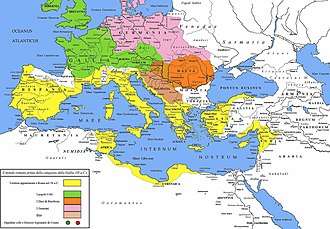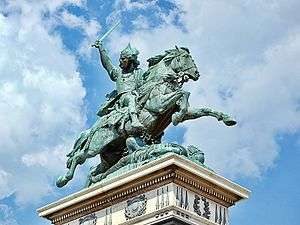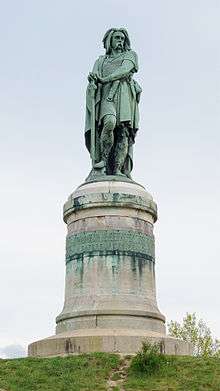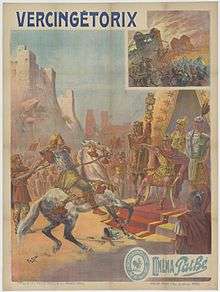Vercingetorix
Vercingetorix (/ˌvɜːrsɪnˈdʒɛtərɪks, -ˈɡɛt-/ VUR-sin-JET-ər-iks, -GET-, Latin: [wɛrkɪŋˈɡɛtɔriːks]; c. 82 BC – 46 BC) was a king and chieftain of the Arverni tribe who united the Gauls in a revolt against Roman forces during the last phase of Julius Caesar's Gallic Wars.
Vercingetorix | |
|---|---|
 | |
| King and chieftain of the Arverni tribe | |
| Personal details | |
| Born | 82 BC Gergovia |
| Died | 46 BC (aged 36–37) Rome |
| Cause of death | Execution by Strangulation |
Vercingetorix was the son of Celtillus the Arvernian, leader of the Gallic tribes. Vercingetorix came to power after his formal designation as chieftain of the Arverni at the oppidum Gergovia in 52 BC. He immediately established an alliance with other Gallic tribes, took command, combined all forces and led them in the Celts' most significant revolt against Roman power. He won the Battle of Gergovia against Julius Caesar in which several thousand Romans and their allies were killed and the Roman legions withdrew. Caesar had been able to exploit Gaulish internal divisions, easily to subjugate the country and Vercingetorix's attempt to unite the Gauls against Roman invasion came too late.[2][3] At the Battle of Alesia, also in 52 BC, the Romans besieged and defeated his forces; to save as many of his men as possible, he gave himself to the Romans. He was held prisoner for five years. In 46 BC, as part of Caesar's triumph, he was paraded through the streets of Rome and then executed by strangulation. Vercingetorix is primarily known through Caesar's Commentarii de Bello Gallico (Commentaries on the Gallic War). To this day, he is considered a folk hero in Auvergne, his native region.
Name
The name Vercingetorix derives from the Gaulish ver- ("over, superior" – an etymological cognate of Cornish gor-, Irish for-, more distantly English over, German über, Latin super, or Greek hyper),[4] cingeto- ("warrior", related to roots meaning "tread, step, walk", so possibly "infantry"; compare Old Irish cingid),[5][4] and rix ("king") (cf. Welsh rhi, Latin rex), thus literally either "great warrior king" or "king of great warriors".[5][4][6][7] In his Life of Caesar, Plutarch renders the name as Vergentorix.[8]
History
Context



Having been appointed governor of the Roman province of Gallia Narbonensis (modern Provence) in 58 BC, Julius Caesar proceeded to conquer the Gallic tribes beyond over the next few years, maintaining control through a careful divide and rule strategy. He made use of the factionalism among the Gallic elites, favouring certain noblemen over others with political support and Roman luxuries such as wine. Attempts at revolt, such as that of Ambiorix in 54 BC, had secured only local support, but Vercingetorix, whose father, Celtillus, had been put to death by his own countrymen for seeking to rule all of Gaul, managed to unify the Gallic tribes against the Romans and adopted more current styles of warfare.
Averni Nobleman
The revolt that Vercingetorix came to lead began in early 52 BC while Caesar was raising troops in Cisalpine Gaul. Believing that Caesar would be distracted by the turmoil in Rome following the death of Publius Clodius Pulcher, the Carnutes, under Cotuatus and Conetodunus, made the first move, slaughtering the Romans who had settled in their territory.
Vercingetorix, a young nobleman of the Arvernian city of Gergovia, roused his dependents to join the revolt, but he and his followers were expelled by Vercingetorix's uncle Gobanitio and the rest of the nobles because they thought opposing Caesar was too great a risk. Undeterred, Vercingetorix raised an army of the poor, took Gergovia, and was hailed as king.[9]
Tribal alliances
He made alliances with other tribes, and having been unanimously given supreme command of their armies, imposed his authority through harsh discipline and the taking of hostages.
He adopted a policy of retreating to natural fortifications, and undertook an early example of a scorched earth strategy by burning towns to prevent the Roman legions from living off the land. Vercingetorix scorched much of the land marching north with his army from Gergovia in an attempt to deprive Caesar of the resources and safe haven of the towns and villages along Caesar's march south.
Siege of Avaricum
However, the capital of the Bituriges, Avaricum (near modern-day Bourges), a Gallic settlement directly in Caesar's path, was spared. Due to the town's strong protests, naturally defensible terrain, and apparently strong man-made reinforcing defenses, Vercingetorix decided against razing and burning it. Leaving the town to its fate, Vercingetorix camped well outside of Avaricum and focused on conducting harassing engagements of the advancing Roman units led by Caesar and his chief lieutenant Titus Labienus. Upon reaching Avaricum, however, the Romans laid siege and eventually captured the capital.
Afterwards, in a contemptuous reprisal for 25 days of hunger and of laboring over the siegeworks required to breach Avaricum's defenses, the Romans slaughtered nearly the entire population, some 40,000 people, leaving only about 800 alive.[10]
Battle of Gergovia
The next major battle was at Gergovia, capital city of the Arverni. During the battle, Vercingetorix and his warriors crushed Caesar's legions and allies, inflicting heavy losses. Vercingetorix then decided to follow Caesar but suffered heavy losses (as did the Romans and their allies) during a cavalry battle and he retreated and moved to another stronghold, Alesia.
Battle of Alesia
In the Battle of Alesia in September 52 BC, Caesar built a fortification around the city to besiege it. However, Vercingetorix had summoned his Gallic allies to attack the besieging Romans. These forces included an army of Arverni led by Vercingetorix's cousin Vercassivellaunos and an army of 10,000 Lemovices led by Sedullos.
With the Roman circumvallation surrounded by the rest of Gaul, Caesar built another outward-facing fortification (a contravallation) against the expected relief armies, resulting in a doughnut-shaped fortification. The Gallic relief came in insufficient numbers: estimates range from 80,000 to 250,000 soldiers. Vercingetorix, the tactical leader, was cut off from them on the inside, and without his guidance the attacks were initially unsuccessful. However, the attacks did reveal a weak point in the fortifications and the combined forces on the inside and the outside almost made a breakthrough. Only when Caesar personally led the last reserves into battle did he finally manage to prevail. This was a decisive battle in the creation of the Roman Empire.
According to Plutarch, Caes. 27.8-10, Vercingetorix surrendered in a dramatic fashion, riding his beautifully adorned horse out of Alesia and around Caesar's camp before dismounting in front of Caesar, stripping himself of his armor and sitting down at his opponent's feet, where he remained motionless until he was taken away.[11][12] Caesar provides a first-hand contradiction of this account, De Bell. Gal. 7.89, describing Vercingetorix's surrender much more modestly.[13]
Memorials


Napoleon III erected a 7-metre-tall (23 ft) Vercingétorix monument in 1865, created by the sculptor Aimé Millet, on the supposed site of Alesia. The architect for the memorial was Eugène Viollet-le-Duc.[15] The statue still stands. The inscription on the base, written by Viollet-le-Duc, which copied the famous statement of Julius Caesar, reads (in French):
La Gaule unie
Formant une seule nation
Animée d'un même esprit,
Peut défier l'Univers.
Gaul united,
Forming a single nation
Animated by a common spirit,
Can defy the Universe.
Many other monumental statues of Vercingetorix were erected in France during the 19th century, including one by Frédéric Bartholdi on the Place de Jaude in Clermont-Ferrand.[16]
Asteroid
Asteroid 52963 Vercingetorix, discovered by the OCA–DLR Asteroid Survey, was named in his honor.[17] The official naming citation was published by the Minor Planet Center on 25 September 2018 (M.P.C. 111800).[18]
See also
References
- Bakker, Marco. "Reportret: Vercingetorix". www.reportret.info. Retrieved 1 April 2018.
- "France: The Roman conquest". Encyclopædia Britannica Online. Encyclopædia Britannica. Retrieved April 6, 2015.
Because of chronic internal rivalries, Gallic resistance was easily broken, though Vercingetorix's Great Rebellion of 52 BC had notable successes.
- "Julius Caesar: The first triumvirate and the conquest of Gaul". Encyclopædia Britannica Online. Encyclopædia Britannica. Retrieved February 15, 2015.
Indeed, the Gallic cavalry was probably superior to the Roman, horseman for horseman. Rome's military superiority lay in its mastery of strategy, tactics, discipline, and military engineering. In Gaul, Rome also had the advantage of being able to deal separately with dozens of relatively small, independent, and uncooperative states. Caesar conquered these piecemeal, and the concerted attempt made by a number of them in 52 BC to shake off the Roman yoke came too late.
- Matasović 2017, p. 398.
- Matasović 2017, p. 200.
- Evans, D. Ellis (1967). Gaulish personal names: a study of some Continental Celtic formations. Clarendon P. pp. 121 & 122.
- X., Delamarre (2003). Dictionnaire de la langue gauloise : une approche linguistique du vieux-celtique continental (2e éd. rev. et augm ed.). Paris: Errance. p. 314. ISBN 9782877723695. OCLC 354152038.
- Plutarch, Life of Caesar 25; 27.
- Julius Caesar, Commentaries on the Gallic War Book VII, sect. 4.
- Julius Caesar, Commentaries on the Gallic War vii.
- Plutarch's Lives; Caes. 27.8-10; Flor. 1.45.26; Dio 40.41.3. Medieval French Historians are also partly responsible for romanticising Vercingetorix's surrender. Romancing the Past: The Rise of Vernacular Prose Historiography in Thirteenth-Century France, by Gabrielle M. Spiegel, page 143, Berkeley: 1993.
- Plutarch. "The Life of Julius Caesar". The Parallel Lives. Loeb Classical Library Edition. Retrieved 15 July 2015.
- Commentaries on the Gallic Wars, Everyman's Edition, 1953 (Trans: John Warrington); Book VII, sect. 89.
- Dio 40.41.3, 43.19.4
- Statue of Vercingetorix, Art and Architecture, 2006
- Dietler, Michael, "Our ancestors the Gauls": archaeology, ethnic nationalism, and the manipulation of Celtic identity in modern Europe (7.3M), American Anthropologist, 1994, 96: 584–605. Dietler, M., A tale of three sites: the monumentalization of Celtic oppida and the politics of collective memory and identity, World Archaeology, 1998, 30: 72–89.
- "52963 Vercingetorix (1998 TB16)". Minor Planet Center. Retrieved 17 October 2018.
- "MPC/MPO/MPS Archive". Minor Planet Center. Retrieved 17 October 2018.
Bibliography
- Julius Caesar, Commentarii de Bello Gallico Book 7
- Dio Cassius, Roman History 40:33–41, 43:19
- Matasović, Ranko (2017). Etymological Dictionary Of Proto Celtic. Brill Publishers. ISBN 978-90-04-17336-1.
- Plutarch, Life of Caesar 25–27
External links
| Wikimedia Commons has media related to Vercingetorix. |
- A reconstructed portrait of Vercingetorix, based on historical sources, in a contemporary style.
- Curchin, Leonard A. Lingua Gallica (The Gaulish Language). Retrieved January 23, 2010 from Uwaterloo.ca
- Paul Marius Martin, Vercingétorix : le politique, le stratège. Paris : Perrin, 2000, 260 p. ISBN 2-262-01691-7.